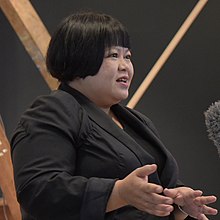
Melati Suryodarmo

Melati Suryodarmo | |
|---|---|
 Suryodarmo in 2019 | |
| Born | 12 July 1969 |
| Nationality | Indonesian |
| Alma mater | Padjadjaran University Braunschweig University of Art |
| Known for | Performance art endurance art |
| Notable work | Exergie – Butter Dance |
Melati Suryodarmo (born 12 July 1969) is an Indonesian durational performance artist. Her physically demanding performances make use of repetitive motions and often last for many hours, sometimes reaching "a level of factual absurdity". Suryodarmo has performed and exhibited throughout Europe and Asia as well as in North America. Born in Surakarta, she attended Padjadjaran University, graduating with a degree in international relations before moving to Germany. She lived there for 20 years, studying performance art at the Braunschweig University of Art with Butoh choreographer Anzu Furukawa and performance artist Marina Abramović.

Suryodarmo later returned to Indonesia and founded Undisclosed Territory, an annual festival for performance art. She was the first woman to serve as artistic director for the Jakarta Biennale. Suryodarmo has been called "one of the most famous performance artists to come out of Indonesia."[1] In 2022, she was awarded the eleventh Bonnefanten Award for Contemporary Art (BACA) by the Bonnefantemuseum.[2]

Early life and education
Melati Suryodarmo was born on 12 July 1969 in Surakarta, Indonesia.[3] Her mother, a traditional Javanese dancer, died when she was young.[4] Her father, Suprapto "Prapto" Suryodarmo,[5] was a meditative performer and practitioner of Amerta.[1][6][7] Melati has been a dancer since she was a child.[6] She learned Tai Chi early on and began learning Sumarah mediation at the age of 11.[6] Suryodarmo attended Padjadjaran University in Bandung. She participated in student demonstrations against the Suharto regime in late 1980s[8] and was part of the underground student association.[6] She graduated with a degree in international relations and politics in 1993.[6] Suryodarmo was involved in theatre and dance performances from 1988 to 1995.[9]

Suryodarmo left Indonesia in 1994, moving to Braunschweig, Germany. She found work retouching photographs and planned to continue her studies in international relations.[10] Following a chance meeting at the city's botanical gardens with Japanese Butoh choreographer Anzu Furukawa,[10] Suryodarmo developed an interest in performance art.[1] She studied sculpture and performance art at the Braunschweig University of Art under Furukawa, who she describes as her "biggest influence in thinking."[6] In addition to learning Butoh from Furukawa, Suryodarmo also learned choreography, costume design and staging.[4] In 1996, she was part of the dance performance Kashya-kashya Muttiku with Yuko Negoro at FBZ in Braunschweig.[9] Suryodarmo later took classes from performance artist Marina Abramović.[11] Suryodarmo received a fine arts degree in 2001 and an MFA in performance art in 2002.[12][3] She later worked as an assistant for Abramović. Suryodarmo performed as a "living installation" alongside her former professor during the 2003 Venice Biennale.[10][1] Suryodarmo also studied time-based art with Mara Mattuschka.[13]

Art career
After living in Germany for 20 years, Suryodarmo moved back to Indonesia in 2013.[6] There she has worked towards popularising performance art in the country.[14] Suryodarmo founded the performance art festival Undisclosed Territory in 2007 in her hometown of Solo.[1] The annual festival includes workshops for youth featuring local artists.[4] In 2012, she converted her home studio into Studio Plesungan, an art lab for Undisclosed Territory and performance art workshops.[4] From 2013 to 2016, Suryodarmo served as guest lecturer at Indonesian Institute of the Arts, Yogyakarta.[4]

In 2017, Suryodarmo was the first woman to have the role of artistic director for the Jakarta Biennale.[4] She had a solo exhibition at Museum Macan in 2020.[15]

Works
Suryodarmo typically produces one or two new performances every year. Many of Suryodarmo's pieces are physically demanding, durational forms of performance art.[1] Her use of repetitive motions in long performances creates meaning by stripping down movement and actions to their barest essentials. Rather than plan out her emotions for her pieces, Suryodarmo is "planning a platform of action with many considerations of thought."[4] Suryodarmo has said of her work, "I intend to touch the fluid border between the body and its environment through my art works. I aim to create a concentrated level of intensity without the use of narrative structures. ...I love it when a performance reaches a level of factual absurdity."[16] Aside from performance art, she also works in installation, video, and photography.[10] She has performed throughout Europe and Asia as well as in North America.[9]

In a review of Suryodarmo's works, Michelle Antoinette wrote that her performance art is a "vehicle for coming to terms with conflicting aspects of her identity," particularly as a woman within the context of Indonesian culture and cross-culturally as a resident of both Germany and Indonesia.[14] In a review for ArtAsiaPacific, Eva McGovern-Basa writes that Suryodarmo's long durational pieces often involve repetitive actions that "deal with physical restraint, resistance and transformation as well as the contemplation of carefully selected objects and environments that trigger poetic movement."[4]

Exergie – Butter Dance
Exergie – Butter Dance is among Suryodarmo's most iconic works. She debuted the 20-minute performance in 2000 at Berlin's Hebbel Theatre. Suryodarmo enters to the sound of ceremonial Indonesian drumming that usually accompanies the Pakarena, a Bugis dance from Makassar, South Sulawesi.[10][8] Wearing high-heeled shoes and a fitted black dress, she begins dancing, treading on 20 blocks of butter that have been arranged on the floor. As the tempo of the drumming increases and the butter melts, she slips and drops to the ground. After each fall, she stands up and begins to dance again, repeating the entire process.[10] The anticipation of each inevitable fall creates a tension for the audience, generating both sympathy and fascination at her perseverance despite the apparent futility of her actions.[4] The work sprang from an assignment by her teacher Abramović for students to create a piece using only €10. Exergie – Butter Dance has had over 20 separate performances. According to Suryodarmo, "the aim of making this work is to get up. You can fail, but you do it anyway. You seldom expose how to get up when you fail."[8]

An edited video of Exergie – Butter Dance was uploaded to YouTube as the "Adele Butter Dance" in 2012. In the video, Suryodarmo's 2010 performance at the Lilith Performance Studio is paired with Adele's 2011 song "Someone Like You". By 2014, the video had received over 1 million views, prompting an article about her in The New York Times. In the article, Rachel Will wrote that the video turned Suryodarmo into "one of the most famous performance artists to come out of Indonesia."[1]

Why Let the Chicken Run?
Why Let the Chicken Run? is a 15-minute performance where Suryodarmo chases a chicken. The work, first performed in 2001, is a response to Ana Mendieta's 1972 work, Death of a Chicken. The work symbolises people's "relentless pursuits in life."[7]

Lullaby for the Ancestors
In Suryodarmo's 2001 piece Lullaby for the Ancestors she repeatedly walks in a circle around a horse while cracking a whip then dunks her head in a bucket of water.[7] The work is based on Jaran Kepang, a traditional Javanese dance where the dancers enter a trance and endure physical trials.[8]

Alé Lino
In Suryodarmo's 2003 piece Alé Lino, she spends three hours leaning into a 4 m (13 ft) pole resting on her solar plexus. Inspired by her research into the Bissu, an androgynous gender of the Bugis people, Alé Lino is an exploration of the "physicality of emptiness".[15]

The Black Ball

Suryodarmo devised the 2005 piece The Black Ball for a retrospective on painter Egon Schiele. Inspired by Schiele's 1912 drawing Organic Movement of a Chair and Jug, she held a black ball while sitting silently on a chair fixed to the museum's wall, high above the floor. During the first four days of the performance, she sat in the chair for eight-hour stretches.[14]

I Love You
Suryodarmo's 2007 piece I Love You was first performed in Barcelona. For the piece, she carries a 70-pound pane of glass, and repeats the words "I love you" for four hours. She has performed I Love You in England, Sweden, and Malaysia.[1]

I Am a Ghost in My Own House
In her 2012 work I Am a Ghost in My Own House, she explores consciousness related to family. In the piece, Suryodarmo silently crushes and grinds charcoal briquettes for 12 hours.[1] The work premiered as a solo exhibition at Bandung's Lawangwangi Creative Space. By destroying a substance capable of creating energy (charcoal), Suryodarmo communicates a sense of loss.[10]

The Acts of Indecency
In 2012, Suryodarmo created a photographic series influenced by Egon Schiele called The Acts of Indecency in 2012. In the work, she exposes her legs and is dressed in a tutu, wearing torn stockings stuffed with either ping pong balls or nails.[7]

Dialogue With My Sleepless Tyrant
In Suryodarmo's two-hour 2013 work Dialogue With My Sleepless Tyrant, she lies down, sandwiched in the middle of tower of mattresses. Only her head is visible, sticking out from the 18-mattress stack, and her hair hangs down the side. Inspiration for the performance piece came from the fairy tale "The Princess and the Pea".[10]

Transaction of Hollows
In her piece Transaction of Hollows, Suryodarmo shoots arrows at gallery walls using a Javanese bow.[15] In one performance, she shot 800 arrows until her fingers began bleeding.[6][17]

Exhibitions and residencies
- 2006: Grace Exhibition Space, New York
- 2006: Loneliness in the Boundaries, a solo exhibition at Cemeti Art House[18]
- 2007: "Artist in Studio 2007" at Lilith Performance Studio, Sweden
- 2009: "Workshop at the Academy of Fine Arts" at Umeå University, Sweden
- 2010: "IASPIS Residency" in Umeå and Saxnäs, Sweden
- 2011: residency at Manila Contemporary, Philippines
- 2012: residency at the Waremill Center, New York, USA[9]
- 2014: APB Foundation Signature Art Prize, Singapore Art Museum, Singapore[19]
- 2015: The 8th Asia Pacific Triennial of Contemporary Art (APT8), Queensland Art Gallery & Gallery of Modern Art, Queensland, Australia[20]
- 2016: Singapore Biennale 2016: An Atlas of Mirror, Singapore Art Museum, Singapore[21]
- 2017: SUNSHOWER: Contemporary Art from Southeast Asia 1980s to Now, National Art Centre Tokyo, Mori Art Museum, Tokyo, Japan[22]
- 2018: TIMORIBUS, ShanghART Gallery, Singapore[23]
- 2019: Contemporary Worlds: Indonesia, National Gallery of Australia, Canberra, Australia[24]
- 2020: Why Let The Chicken Run?, Museum MACAN, Jakarta, Indonesia[25]
- 2023: Ikon gallery in Birmingham PASSIONATE PILGRIM
- 2024: I am your Body: Chapter 2 - Flesh, Kunsthal Aarhus, Aarhus, Denmark
Personal life
Suryodarmo married her first husband in Indonesia. In 1994, they moved to Braunschweig, Germany.[10] She has a daughter and has lived in Groß Gleidingen, Germany. She is Buddhist.[6]

References
- ^ a b c d e f g h i Will, Rachel (12 June 2014). "Indonesia's Maverick Performance Artist". The New York Times. Archived from the original on 13 June 2014.
- ^ "Bonnefanten Award 2022 for Melati Suryodarmo". Bonnefanten Award 2022 for Melati Suryodarmo — Bonnefanten Maastricht. Archived from the original on 23 October 2021. Retrieved 15 October 2021.
- ^ a b "About". Melatisuryodarmo.com. Archived from the original on 26 October 2020. Retrieved 19 August 2020.
- ^ a b c d e f g h i McGovern-Basa, Eva (November 2017). "Melati Suryodarmo: The world within". ArtAsiaPacific (106): 72–83. Archived from the original on 18 January 2021. Retrieved 31 August 2020.
- ^ Cohen, Matthew Isaac (2016). "Embodied Lives: Reflections On the Influence of Suprapto Suryodarmo and Amerta Movement ed. by Katya Bloom, Margit Galanter, and Sandra Reeve". Asian Theatre Journal. 33 (1): 233–236. doi:10.1353/atj.2016.0009. S2CID 163309329.
- ^ a b c d e f g h i Melati Suryodarmo: Body as Container (Complete). asiasociety.org. 15 October 2019. Archived from the original on 13 August 2020. Retrieved 31 August 2020.
- ^ a b c d Amador, Tanya (14 April 2020). "Why Did Melati Suryodarmo Let the Chicken Run?". Plural Art Mag. Archived from the original on 2 June 2020.
- ^ a b c d Chotrani, Chloe (16 October 2019). "Melati Suryodarmo: Culture, performance, and womanhood". Esplanade Offstage. Archived from the original on 30 January 2021. Retrieved 31 August 2020.
I grew up around these trance rituals, observing it as a child. In the '70s, I would witness trance people eating glass bulbs, sometimes these men were whipped, they have these large masks with peacock feathers and would do trance dances.
- ^ a b c d "Karya-Karya Melati Suryodarmo" (in Indonesian). Indonesian Visual Art Archive. August 2016. Archived from the original on 24 February 2020. Retrieved 31 August 2020.
- ^ a b c d e f g h i Tsai, Sylvia (September 2013). "Unspoken Language: Melati Suryodarmo". ArtAsiaPacific. Archived from the original on 8 August 2020. Retrieved 31 August 2020.
- ^ Spielmann, Yvonne (2017). Contemporary Indonesian Art: Artists, Art Spaces, and Collectors. NUS Press. pp. 127–131. ISBN 978-981-4722-36-0.
- ^ Swastika, Alia; Gopinath, Suman (2011). Biennale Jogja XI 2011 Catalogue. Yogyakarta: Yayasan Biennale Yogyakarta. p. 65. ISBN 978-602-19374-0-2.
- ^ Future of Imagination 5. International Performance Art Event in Singapore, essays, artist interviews and biographies. 2008. p. 44. CiteSeerX 10.1.1.458.1069. ISBN 978-981-08-1956-9.
- ^ a b c Antoinette, Michelle (March 2017). "Endurance and Overcoming in the Art of Amron Omar and Melati Suryodarmo: Invoking Uncommon Alignments for Contemporary Southeast Asian Art History". Southeast of Now: Directions in Contemporary and Modern Art in Asia. 1 (1): 81–129. doi:10.1353/sen.2017.0003. S2CID 160025825. Archived from the original on 26 April 2019. Retrieved 31 August 2020.
- ^ a b c John, Jones (6 May 2020). "Melati Suryodarmo enthralls with new forms of art practice at Museum MACAN". Stir. Archived from the original on 26 September 2020. Retrieved 31 August 2020.
- ^ McAlpine, Fraser (April 2012). "Adele 'Butterdance' Video Explained". BBC America. Archived from the original on 11 August 2020. Retrieved 31 August 2020.
- ^ Chia, Adeline (18 April 2018). "Melati Suryodarmo: Timoribus at Shanghart, Singapore". ArtReview. Archived from the original on 29 September 2021. Retrieved 8 September 2020.
On the second day, the skin on her fingers starts to tear. Blood twangs off the bowstring and speckles her face and clothes.
- ^ Bianpoen, Carla; Wardani, Farah; Dirgantoro, Wulan (2007). Indonesian Women Artists: The Curtain Opens. Jakarta: Yayasan Senirupa Indonesia. p. 197. ISBN 9789791656207.
- ^ "ArtAsiaPacific: 2014 Signature Art Prize Exhibition". artasiapacific.com. Archived from the original on 1 April 2015. Retrieved 15 October 2021.
- ^ "APT8 | Melati Suryodarmo". QAGOMA Blog. 30 October 2015. Archived from the original on 24 October 2021. Retrieved 15 October 2021.
- ^ "Singapore Biennale 2016 | Singapore Art Museum". www.singaporeartmuseum.sg. Retrieved 15 October 2021.
- ^ "SUNSHOWER: Contemporary Art from Southeast Asia 1980s to Now | Exhibitions | THE NATIONAL ART CENTER, TOKYO". www.nact.jp. Archived from the original on 29 October 2021. Retrieved 15 October 2021.
- ^ "Melati Suryodarmo: TIMORIBUS". Archived from the original on 23 October 2021. Retrieved 15 October 2021.
- ^ "Contemporary Worlds". nga.gov.au. Archived from the original on 17 October 2021. Retrieved 15 October 2021.
- ^ Hutomo, Hendhy. "Melati Suryodarmo: Why Let the Chicken Run?". Museum MACAN (in Indonesian). Retrieved 15 October 2021.
External links
- Artist website
- Adele Butter Dance on YouTube
- Undisclosed Territory
- Melati Suryodarmo: Performance Art as Trigger in Conversation with Christina Sanchez-Kozyreva on Ocula
See what we do next...
OR
By submitting your email or phone number, you're giving mschf permission to send you email and/or recurring marketing texts. Data rates may apply. Text stop to cancel, help for help.
Success: You're subscribed now !



